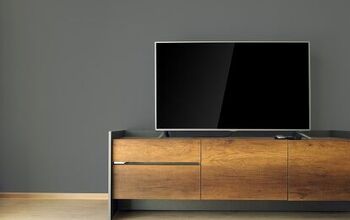TV Keeps Going Black For A Few Seconds? (Possible Causes & Fixes)

TVs are wonderful additions to your home — when they work correctly. There are many issues that can come up, from TVs being too loud or too quiet, being too dim, all the way up to the dreaded ‘black screen of death’. But luckily, many of these issues are relatively simple to fix.
There are a few reasons why your TV screen could keep going black for a few seconds. Unfortunately for the DIY-ers out there, most of these are best handled by a professional. But that doesn’t mean there aren’t some quick fixes that can work as well.
The most common cause of a TV screen going black is some kind of loose connection, inactive power supply, or damaged cables. It can also be caused by the TV’s energy-saving mode or sleep timer being switched on. If you’ve switched both of these things off and are still having issues, contact support.
Here, we’ll walk you through some small fixes you can do at home and let you know when it’s time to call in a technician. There are several reasons why your TV screen could be going black for a few seconds, so let’s look at them one by one.
Do You Need a Home Theather System Installed?
Get free, zero-commitment quotes from pro contractors near you.

Potential Issues With Your TV Going Black
Loose Connections
A loose connection in the TV itself is a common cause of an intermittent black screen. If you’ve run through all of the potential fixes listed here and are still experiencing a black screen for several seconds at a time, this is likely the cause. If this is the case, your best bet is to contact support or bring the TV to a reputable repair shop.
Video: Why Is My HDMI Signal Dropping Out?
Damaged Cables
Damage to cables can happen during transit. Broken, frayed, or otherwise damaged cables may not be able to transmit information correctly, resulting in a screen that randomly goes black for a few seconds every so often as the connection is lost between internal components.
Power Supply
Make sure that all your cables are plugged in tightly to functional outlets. If you’re concerned at all about whether your outlets are functioning correctly, you can check them by plugging a small appliance such as a lamp into them. If the small appliance works, the outlet works.
Power Boards
Sometimes the cause of the intermittent black screen is the failure of one of the TV’s internal power boards. These boards pull a lot of weight when it comes to a TV’s picture, so if one of them fails, you’re likely to see a flickering screen.
Overheating
Sometimes a TV will shut itself off intermittently to avoid damaging its own internal components if it is overheating. If you suspect your TV might be overheating, contact the brand’s support team and have it inspected.
What Does it Mean if My TV Goes Dark But Still Has Sound?
While any of these issues can cause a black screen with sound, there is one more potential cause that we haven’t touched on. Depending on the type of TV you’re using, the fault may also be in the connecting HDMI cable.
It’s best to replace the cable if you think this may be the issue. Then, unplug the TV for 5 minutes to attempt a full reset. This should fix the black screen issue.
What Can I Do?
Often there isn’t much you as a homeowner can do about your TV going black for several seconds, short of calling in the professionals. That’s not to say you’re completely out of your depth though. There are a few things you can do to make it a little easier for a professional to diagnose the problem, or potentially to fix the issue yourself.
Sound Test
A sound test is simple to conduct and can give you some valuable insight into the cause of the issue. During the black screen, get close to the TV and listen to the audio, if it’s still playing. You should be able to hear if anything sounds scratchy, tinny, or otherwise strange. This can be a clue as to whether the TV’s internal components are in good working order.
If nothing else seems affected, this is a good indication that it’s something like the backlight going out, or a loose connection or damaged internal cable.
Light Test
A light test will help you determine if it is one of the TV’s power boards or back lights that is struggling. During the black screen, aim a flashlight at the screen. If you can see an image, then one of the TV’s panels has failed and will need to be replaced.
Input
If the screen is continuously black, the problem may be as simple as changing the input on your television. A TV set to the wrong input won’t be picking up the visual signal, even if it’s being broadcasted clearly.
Sleep Timer
It’s possible that the solution is as simple as turning off the sleep timer on your device. The sleep timer tells the TV when to power down for the night presumably after the homeowner has fallen asleep with it on. To fix this issue, find your sleep timer settings from your general menu and either switch it off or set it to a time you feel better about.
Energy Saver Mode
Like with the Sleep Timer fix, the solution to this one is relatively simple. First, find the Energy Saver Mode settings in your menu. From there, you should be able to switch it to the ‘Off’ position. This should fix the issue.
Brightness Settings
While it’s not likely that this would be the cause of the issue, we can’t entirely rule it out. If you notice your TV is generally dim, you may want to look into the overall brightness settings and see if any presets have been running that may explain the random black screen.
If you’ve gone through all of these possible fixes and are still experiencing issues, then it’s time to call in a technician.
How Do You Know if a TV’s Backlight is Burned Out?
The simplest way to tell if your TV’s backlight is burned out is to perform the light test mentioned above. Make sure the TV is on, and turn off all other light sources in the room. Then, shine a flashlight at the screen. If you can see the picture with the flashlight, it means that the TV’s backlight is burned out and will need to be replaced.
Can a Backlight be Fixed?
Absolutely. If the issue is with the power supply or the backlight, it’s generally a pretty simple fix. The problem most commonly comes from the internal high voltage inverter circuitry. Faulty transistors or capacitors are a relatively common find. Thermal stress leading to broken solder joints on the circuit board can also occur.
Fixing the internal issues is sometimes seen as a short-term solution, but can be more than an adequate fix on its own.
Related Questions
What is an HDMI ‘Handshake’?
An HDMI Handshake is essentially the process of getting the source (streaming device, gaming console, etc.) and the sink (projector, monitor, or television) to recognize each other. This helps them determine that they’re both authorized to carry the HDMI signal, and this handshake process is continuously repeated while a signal is running through the HDMI cable pathway.As you might imagine, a lot can go wrong with this seemingly simple process. If the handshake process has been interrupted somehow due to a faulty HDMI cable or connector, the result may be a black screen.
How much does it cost to fix the backlight on a TV?
The average TV backlight repair will cost you anywhere from 100 to 125 dollars out the door. If you’re having the unit repaired at home, be prepared to pay a bit more in travel time fees. The overall price of replacement backlight parts averages around $2.50 for an LED, and between $20-$25 for a CCFL strip.
What causes LED backlight failure?
One of the common causes of backlight circuit failure is damage to the electrical traces that are found on the circuit board itself. If these traces are severed, then the board will not conduct power to the backlight correctly. Damage of this kind can occur from things like attempting to attach the circuit board with too large of a screw.
Do You Need a Home Theather System Installed?
Get free, zero-commitment quotes from pro contractors near you.

The Bottom Line
There are a lot of things that can potentially cause an intermittent black screen in a television. Most of them are best diagnosed and handled by professionals, but a competent DIY-er could realistically change out the back lights on a TV without too much hassle.
At the end of the day, a flickering black screen is indicative of some kind of connection or transmission problem. Check your cables and connections first before you go running to the store for a new TV. If shoring up the connections doesn’t fix the issue, try inspecting your TV’s energy saving mode and sleep timer settings. If this still doesn’t fix the issue, the TV will likely need to be repaired or replaced.

We are a team of passionate homeowners, home improvement pros, and DIY enthusiasts who enjoy sharing home improvement, housekeeping, decorating, and more with other homeowners! Whether you're looking for a step-by-step guide on fixing an appliance or the cost of installing a fence, we've here to help.
More by Upgraded Home Team



























